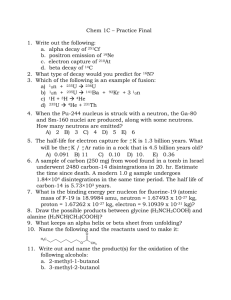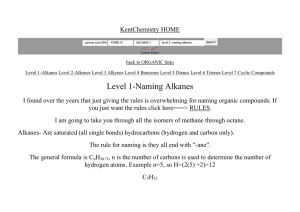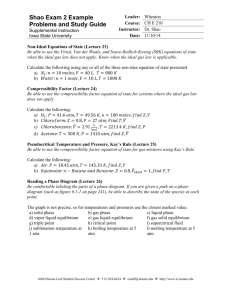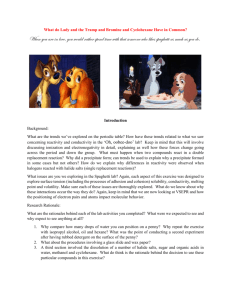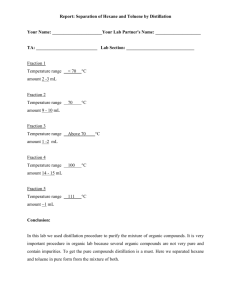Distillation Theory - FacStaff Home Page for CBU
advertisement
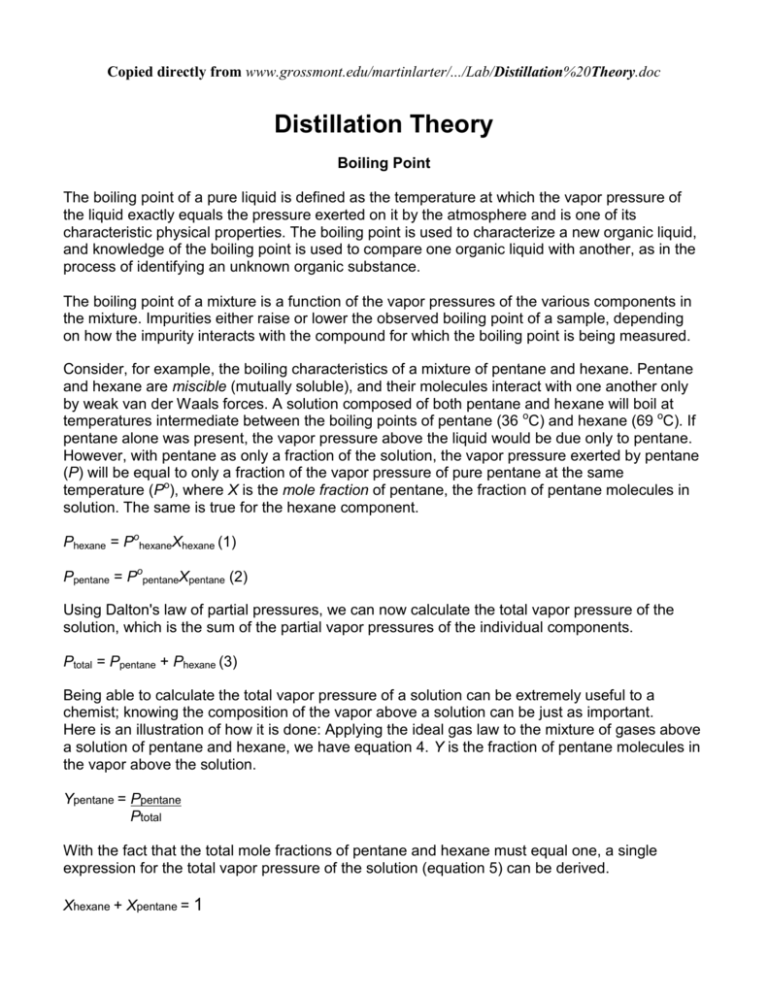
Copied directly from www.grossmont.edu/martinlarter/.../Lab/Distillation%20Theory.doc Distillation Theory Boiling Point The boiling point of a pure liquid is defined as the temperature at which the vapor pressure of the liquid exactly equals the pressure exerted on it by the atmosphere and is one of its characteristic physical properties. The boiling point is used to characterize a new organic liquid, and knowledge of the boiling point is used to compare one organic liquid with another, as in the process of identifying an unknown organic substance. The boiling point of a mixture is a function of the vapor pressures of the various components in the mixture. Impurities either raise or lower the observed boiling point of a sample, depending on how the impurity interacts with the compound for which the boiling point is being measured. Consider, for example, the boiling characteristics of a mixture of pentane and hexane. Pentane and hexane are miscible (mutually soluble), and their molecules interact with one another only by weak van der Waals forces. A solution composed of both pentane and hexane will boil at temperatures intermediate between the boiling points of pentane (36 oC) and hexane (69 oC). If pentane alone was present, the vapor pressure above the liquid would be due only to pentane. However, with pentane as only a fraction of the solution, the vapor pressure exerted by pentane (P) will be equal to only a fraction of the vapor pressure of pure pentane at the same temperature (Po), where X is the mole fraction of pentane, the fraction of pentane molecules in solution. The same is true for the hexane component. Phexane = PohexaneXhexane (1) Ppentane = PopentaneXpentane (2) Using Dalton's law of partial pressures, we can now calculate the total vapor pressure of the solution, which is the sum of the partial vapor pressures of the individual components. Ptotal = Ppentane + Phexane (3) Being able to calculate the total vapor pressure of a solution can be extremely useful to a chemist; knowing the composition of the vapor above a solution can be just as important. Here is an illustration of how it is done: Applying the ideal gas law to the mixture of gases above a solution of pentane and hexane, we have equation 4. Y is the fraction of pentane molecules in the vapor above the solution. Ypentane = Ppentane Ptotal With the fact that the total mole fractions of pentane and hexane must equal one, a single expression for the total vapor pressure of the solution (equation 5) can be derived. Xhexane + Xpentane = 1 Ptotal = Xpentane (Po pentane – Po hexane) + Po hexane (5) Finally, the combination of equations 4 and 5, plus Raoult's law, allows the calculation of the mole fraction of pentane in the vapor state. Ypentane = Po pentane Xpentane (6) o o Xpentane (Popentane – P hexane) + P hexane So, if you know the vapor pressures of pure pentane and pure hexane at various temperatures and the composition of the liquid you can calculate the fraction of pentane in the vapor above the solution. This kind of calculation can be used to construct a temperature-composition diagram, sometimes called a phase diagram Simple Distillation Figure 1.2 Estimated temperature-composition diagram for pentane-hexane solutions at 1.0 atm pressure. It is useful to follow the dotted line in, moving from L1 to V1 to L2, etc. Point L1 indicates a boiling point of 44 oC at atmospheric pressure for a solution containing a 1:1 molar ratio of pentane to hexane. Upon removing a sample of the vapor, we find that it has a molar composition of 87% pentane and 13% hexane as indicated by point V 1. The mole fraction of the component with the lower boiling point is greater in the vapor than in the liquid. If the vapor at V 1 condenses, the liquid that collects (L2) will have the same composition as the vapor (V1). Now, if the condensed liquid (L2) is revaporized, the new vapor will be even richer in pentane (V 2). Repeating the boiling and condensing several more times allow us to obtain pure pentane,uncontaminated by hexane. As pentane is removed in the vapor, the composition of the liquid, originally L1, becomes richer in hexane, the component with the higher boiling point. As the mole fraction of hexane in the liquid increases, the boiling point of th liquid also increases until the boiling point of pure hexane, 69 oC, is reached. In this way pure hexane can also be separated. In a simple distillation, only one vaporization and condensation occurs, corresponding to points L1 and V1. This process would not effectively separate a mixture such as pentane and hexane. If a 1:1 solution of pentane and hexane undergoes a simple distillation, the first vapor that condenses has a molar composition of 87% pentane and 13% hexane. The molar composition of the remaining liquid now contains more hexane and less pentane than originally; consequently, the boiling point of the mixture will increase. As additional vapor condenses into the receiving flask, the boiling point of the remaining mixture continues to increase. We can represent this graphically by a distillation curve showing vapor temperature versus volume of distillate for the simple distillation of our pentane-hexane mixture Figure Distillation curve for a simple distillation of a 1:1 molar solution of pentane and hexane. The initial distillate is collected at a temperature above the boiling point of pure pentane and the final distillate never reaches the boiling point of pure hexane, a result indicating a poor separation of the two compounds. Even though simple distillation does not effectively separate a mixture of liquids whose boiling points differ by less than 60-70 oC, organic chemists use simple distillations in two commonly encountered situations. The last step in the purification of a liquid compound usually involves a simple distillation to obtain the pure product and determine its boiling point. Simple distillation is also used to remove the solvent when recovering an organic compound with a high boiling from a solution. Nomograph - Printer-friendly Page - [www.rhodium.ws] 1 of 1 NOMOGRAPH FOR C A L C U L AT I O N http://www.erowid.org/archive/rhodium/chemistry/equipment/nomograph.... OF BOILING POINTS UNDER VACUUM 8/25/2013 3:46 PM
